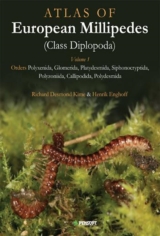|
This is the first in a series of three books which will, for the first time ever, show the distribution of Europe’s more than 1500 species of millipedes on 50 X 50 km square maps. The present volume includes 492 species, including the tiny, beautiful pincushion millipedes, the colourful pill-millipedes and the flat-backed millipedes. The millipede atlas is the result of many years’ meticulous accumulation of records provided by a large number of contributors from all over Europe, interpretation of label data from collections, and scrutiny of old literature. The atlas builds on the taxonomic backbone provided by the Fauna Europaea project which provides information on names, synonyms and distribution by country or region of non-marine European animals.
The decision to produce a series of atlases showing the distribution of myriapods in Europe was taken by the participants at the Fourth International Congress of Myriapodology held in Gargnano in 1978 and soon after this the project received the full backing of the European Invertebrate Survey. Desmond Kime was designated to assemble the data. Much help has been received from the International Centre of Myriapodology in Paris which is acknowledged in this volume, together with the contributions of many members engaged in research in this field. Early in the 21st Century when Henrik Enghoff was playing a major role in Fauna Europaea the two authors joined forces with a view to making this millipede atlas and Fauna Europaea entirely compatible. It is hoped that this atlas will both stimulate and be a foundation for further studies. In several European countries the distribution and often the ecological requirements of millipedes are quite well understood but in many regions the information is fragmentary, the maps revealing where much remains to be done. There are undoubtedly many more species to discover. As a result of the work already undertaken it has become apparent that millipedes are very good bioindicators, being slow-moving and having particular habitat requirements which are helpful in biogeographical and evolutionary studies.
Richard Desmond Kime was born in Spilsby, Lincolnshire, England, on 12th April 1932. He acquired a deep interest in Natural History from his grandfather and was a keen botanist and ornithologist during his student days. He graduated with honours in Zoology at the University of Durham in 1954 and embarked on postgraduate studies which led to a Diploma in Education and a Master’s Degree in Ecology. He taught Biology, Botany and Zoology at the Royal Grammar School in Guildford, Surrey, until 1974 when he was appointed to the European School in Brussels, retiring from teaching in 1993. While in Belgium he became involved in scientific research at the Catholic University of Louvain (1977-2003) and the Belgian Royal Institute of Natural Sciences to which he is still attached. Since 1968 he has particularly studied the soil fauna, publishing several papers on the ecology and biogeography of millipedes. He joined the European Invertebrate Survey in 1982, eventually becoming a vice-president. He published the first volume of Fauna Europaea Evertebrata, a Provisional Atlas of European Myriapods, Part 1, through the agency of the National Museum of Natural History in Luxembourg where he remains,too, an attached research zoologist.
Henrik Enghoff was born in Gentofte north of Copenhagen, Denmark, on 9th December 1948. Starting at a very early age as a bird-watcher, he turned his interest to true bugs (Heteroptera) while still attending school, and then to millipedes when he entered the University of Copenhagen as a student in 1967. He received his Ph.D. from this university in 1976 on a thesis about parthenogenesis in millipedes. Shortly after he was employed in a permanent position at the Natural History Museum (until 2003: Zoological Museum) of the University where he served as director 1996-2007 and is now professor and director of collections. He has had leading positions in several European projects, notably Fauna Europaea (2000-2004). He has published more than 200 scientific papers, mostly on millipede taxonomy, but also on biogeography, postembryonic development, parthenogenesis, centipedes and harvestmen. He has described more than 200 new millipede species, mainly from Madeira, the Canary Islands, and Thailand
|





















